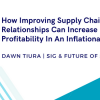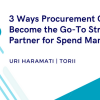Leading companies are working to extend management of the corporate risk profile to road safety. This is achieved by acknowledging key challenges, understanding the big picture and launching well-targeted strategic programs that consider local challenges and solutions. Such programs include driver management (driver selection, development and monitoring), vehicle management (including best use of new technologies) and assessing and managing route risks.
With more than one-quarter of the 1.25 million deaths on the road each year attributable to work-related driving, the threat posed to sustainable business performance due to confining safety risk management to on-site activities is clear. As defensive driver training and driver-monitoring technologies become more mainstream, leading global companies are now taking the significant step of managing all off-site transportation safety risks throughout their own operations and across their chains. While such a step may increase the scope of harm to be addressed by an order of magnitude over that of on-site risks, reducing road transport-related fatalities and injuries throughout the supply chain can strengthen corporate reputation and deliver tangible benefits to business performance.
Highly visible campaigns spotlight non-proactive companies
Road safety is rapidly joining the corporate leadership agenda. Leading companies are now launching group-wide programs to manage road-safety risks in distribution, in particular global companies operating in low- and middle-income countries with less than half of the world’s vehicles but 90% of fatal accidents. According to an analysis of external reporting by 85 of the world’s largest companies across seven sectors, just one-third declare the matter to be a priority, and show considerable variation in prioritising supply-chain safety by sector.
The highly visible campaigns of leading companies are throwing the spotlight onto others that are not proactive. Leading companies recognise that engaging in such emerging practices enhances their reputations in corporate leadership.
Such campaigns have been fueled by rapidly developing technologies such as vehicle telematics and on-board driver-monitoring cameras, enabling low-cost and effective support to safety management of fleets.
A range of benefits
Many road-safety initiatives support good business performance and deliver a range of benefits, for example:
1. Cost savings. Stelios Haji-Ioannou, founder and owner of EasyJet, once said, “If you think safety is expensive, try having an accident…” Direct costs typically involve vehicles (recovery, repairs, insurance premiums) and drivers (injury and absence, replacement drivers, compensation). Further indirect costs are typically much more extensive and not fully covered by insurance (downtime, loss of production, damaged reputation, loss of goodwill and management burden) – and often forgotten when reviewing the incident. ROIs of fitment of driver-monitoring technologies to fleet vehicles are typically measured in months.
2. Competitive edge. Improved governance of safety risk results in highly reliable supply-chain networks, whether transport services are owned or outsourced, in which products are more likely to reach their customers on time.
A broad range of initiatives
The world’s largest companies are introducing a broad range of initiatives to reduce the number of road accidents: defensive driver training and driver-monitoring technologies are becoming more mainstream. Such initiatives present cost-effective initiatives and are rapidly being considered as part of “taking reasonable steps” to manage all off-site transportation safety risks throughout the supply chain.
Consistently collecting and reporting data
A critical enabler to improving road safety is to understand the specific local risk profile by consistently collecting and reporting data on fatalities/incidents. Many organisations do not record or report off-site incidents at corporate level, which makes such matters invisible to their boards, and hence not a corporate priority. From our experience, a critical success factor is to equip the organisation with effective safety governance mechanisms. These actions allow identification of the low-hanging fruit and opportunities to take those reasonable steps. One company determined that pedestrians comprised around half of road-related fatalities in one of the low-income countries where its distribution operations ran. Fitment of side-impact protection to fleet trailers provided a cost-effective risk mitigation – a measure that is rarely beneficial elsewhere.
Leading initiatives from the top
These three elements are critical for success, but often overlooked:
- A large-scale corporate program does not necessarily imply a uniform turnkey solution. Local evaluation of driving culture, the driving environment and underlying causes of accidents is required to develop smart and effective investments rather than a global broad-brush approach.
- Contracted supply-chain fleets are often left out of the safety equation. Contracted operations are sometimes perceived as a way to transfer risks, and for many companies, contractors are viewed as beyond their control and primary concern. Development of suitable formal structures for managing supply-chain risks is perceived as one of the biggest challenges. Companies seeking to progress from “contract-driven” supply-chain safety management to “culture driven” do well to nurture long-term relationships with high-performing contractors. A key factor for success lies in effective evaluation, based on suitable metrics, of performance on an ongoing basis.
- Technology should strengthen rather than replace driver management. Telematic-based black-box and camera technologies are now mainstream and allow real-time monitoring of driver performance. These typically record hard stops, turns, harsh braking, speeding and swift lane-change maneuvers, and can therefore detect unsafe driving practices. Adaptive cruise control and roll stability maintain safe following distances and apply the brakes if a vehicle corners too fast. Effective management programs may include a scheme with clear rewards/sanctions for the drivers. We have seen healthy day-to-day competition between drivers lead to reduced collision rates.
The challenges
- Unlike when managing on-site safety risks, companies have no direct ability to control the actions of third parties on public roads. For companies with extensive road-transport footprints in low-income countries, this is particularly relevant as poor transport infrastructure, together with often-weak road-safety law enforcement and larger numbers of pedestrians and bicycles, lead to dangerous road conditions. The third-party death rate in such countries is significantly higher than in the developed world.
- Clearly, it is impossible to completely remove the risk of an incident or fatality on the road. Organisations should adopt a “take-all-reasonable-steps” approach to determine which initiatives they should use to reduce the fatality/incident rate – steps tailored to the opportunities for control or influence of employees, contractors and third-party communities. One company took a new approach to reduce its incident rate by developing a dynamic distribution route model to avoid high pedestrian risk area near schools and churches. Safer routes are now selected based on the time of the day to avoid peak periods.
Safe-driving initiatives need to be led from the top. Cost-effective and sustained success requires tackling the underlying causes of current accidents and alignment of driver programs with broader company culture – targeting the directly controlled workforce as well as contractual/supplier relationships. Initiatives need to be systematic and embrace driver selection, behaviour, development and monitoring, best use of new technologies to equip vehicles, and assessment of driving routes. With careful assessment and well-thought-out strategies, organisational transport can be realised, as we have found in our experience of supporting global companies.








